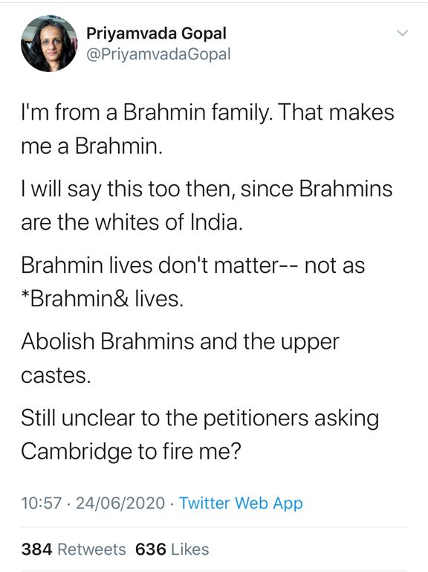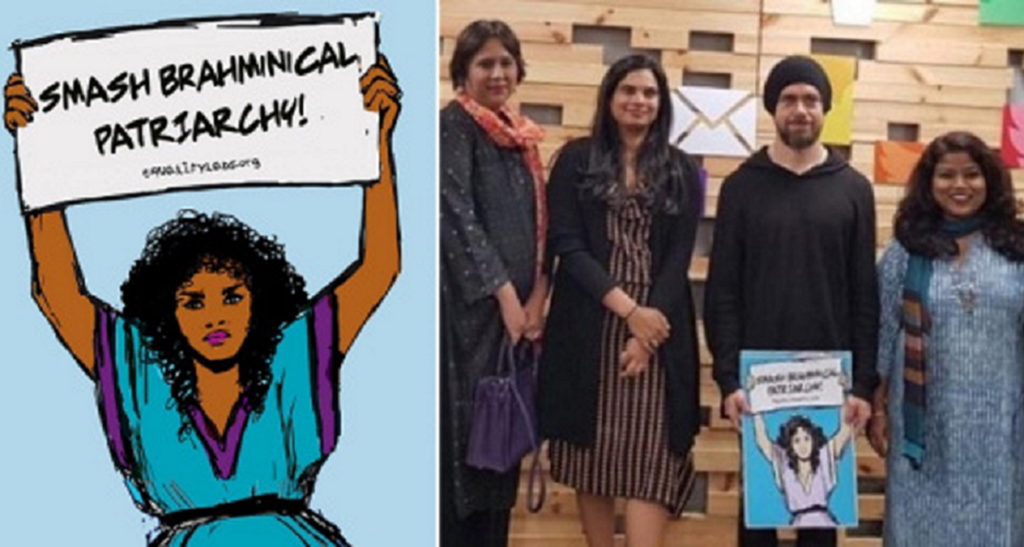The current hyperbolic preoccupation with race in the Anglosphere has provided an opportunity for some to link caste to race as though they are cognate phenomena of oppression. In this article, it is argued that this coupling of caste and race, and depiction of Brahmins as the epitome of whiteness at the apex of the Indian caste system, is actually generated from within the same western framework that treats race as a salient difference. The attempt by post-colonials to present caste as a variant of race tells us nothing about the Indian culture, but rather indexes how they have tried to make the alien western framework of race their own.
 The Brahmin has become a hate figure in contemporary times. Twitter’s CEO Jack Dorsey held up a poster in November 2018 that said ‘Smash Brahminical Patriarchy’. More recently, on June 24th 2020, Priyamvada Gopal, professor at Cambridge University’s Faculty of English, tweeted: ‘I'm from a Brahmin family. That makes me a Brahmin. I will say this too then, since Brahmins are the whites of India. Brahmin lives don't matter—not as *Brahmin & lives. Abolish Brahmins and the upper castes.’ That tweet was followed by another on the same morning: ‘For those at the back: I'm a Brahmin. My Brahmin life does not matter/ Abolish Brahmin-ness.’ Gopal has continued in a similar vein in subsequent tweets.
The Brahmin has become a hate figure in contemporary times. Twitter’s CEO Jack Dorsey held up a poster in November 2018 that said ‘Smash Brahminical Patriarchy’. More recently, on June 24th 2020, Priyamvada Gopal, professor at Cambridge University’s Faculty of English, tweeted: ‘I'm from a Brahmin family. That makes me a Brahmin. I will say this too then, since Brahmins are the whites of India. Brahmin lives don't matter—not as *Brahmin & lives. Abolish Brahmins and the upper castes.’ That tweet was followed by another on the same morning: ‘For those at the back: I'm a Brahmin. My Brahmin life does not matter/ Abolish Brahmin-ness.’ Gopal has continued in a similar vein in subsequent tweets.
Gopal’s tweets came at a time when racial justice is high on the agenda, in the Anglosphere at any rate. Suddenly, an ultra-consciousness appears to have taken hold of British institutions to do everything possible to eliminate racial injustice. No stone can be unturned, from statues of prominent figures to syllabi. Everything must be reviewed. Children and students must be made super-sensitive to race and they must reprimand their elders for racism, which now appears manifest in all they hold dear. A cultural revolution is at play, in the interstices of whose new disciplinarian correctness one must learn to survive.
What has race to do with Brahmins and with upper castes though? Isn’t racial injustice a problem that the Western world is having to deal with as against those other, non-white people, especially those who are in but not of the West, the historical and current targets of racial prejudices?
Race as a salient difference for the western culture: The West has turned out to be a remarkably race-conscious culture. Race is a salient difference that matters in the Western world. People are thought of as belonging to racial groups and such differences have often conditioned how those people are treated. Such differences have mattered in how people are thought about and how policies and laws have been made for them. In the most neutral manner, it is possible to say that the West is a racist culture. In this culture, racism is a problem, but its putative solutions are also racist in as much as they are premised on an ontology of races.
The races according to which different groups of people came to be and are classified, appear parasitic on this underlying racism. That is not to suggest that such classifications have been stable across time or are unchanging. Far from it. At one time, people of different religions may well have borne a racial classification. Racial markers could suggest what nation one was part of. Skin colour has played an important role and continues to. The word ‘race’ has thus had to bear the burden of notions derived from different axes. This points to the instability of the conception of race. It also tells us how Western culture has maintained the salience of race but changed its mind about its relevant content, with different axial threads either succeeding one another as dominant, or concurrently running alongside one another. Racism is effectively the West’s way of working out what differences there are among people. It varies, but with continuities and overlaps.
The sphere of race studies does not answer to scientific criteria. Although there are many contenders, there is no theory of race or racism as such. It is not as though one has a theory that can be tested against facts or become falsified and thereby abandoned. Many incompatible claims can circulate simultaneously. In this sense, it shares the same problems as the social sciences generally. That is why race-talk almost always appears ideological.
These features probably account for why one can keep adding to races, ideas of racism, who or what a race is, the criteria for being a race, and the various classifications of race. ‘Coloured people’ isn’t a term one should use, but ‘people of colour’ is fine, although it is also racist. In Britain’s now superseded Race Relations Act 1976, racial grounds meant any of the following: colour, race, nationality or ethnic and national origins. There was an attempt to have its successor, the Equality Act 2010, make caste ‘an aspect of race’. The result has been effectively achieved with the British judiciary accepting the principle that caste discrimination could amount to race discrimination. The reverse is possible, too. So, Isabel Wilkerson says in The New York Times (July 1st, 2020): ‘In America, race is the primary tool and the visible decoy for caste.’ Caste has been an American thing all along. Who knew?
One can also racialise people, so racialisation is a thing. Muslims are racialised, it is claimed, and are, therefore, like other races. Racism can also be systemic, structural or institutional. A whole society or country can be racist (though this is different from saying that race is a salient difference in a particular culture). In this way, one can keep adding and changing according to specific commitments and agenda. All the while, this swirl within Western culture seems to make sense, even when it may be parochial, a select discourse among a few people, sometimes within a small academic community, or only within a particular country. For instance, in his book Race Politics in Britain and France, Erik Bleich shows how laws against racism in France address quite differently conceptualised problems from their British counterparts and do so in a different way.
Frank Füredi has explained (in his The Silent War: Imperialism and the Changing Perception of Race) how the United Nations International Convention on the Elimination of All Forms of Racial Discrimination of 1965 was proposed and promoted for accession by Anglo-American countries, which were then fighting a battle to contain the challenge to the white supremacy inherent to European imperialism and to homegrown segregation in the US. That is how they latched onto the defensive philosophy of race relations. From 1965 to 2000, relevant British laws bore the title, Race Relations Acts.
However, race picks out a difference to which others in the world do not have access. Last year, this author read some of the contemporaneous UN archives of the 1960s held in the library in Geneva. They reveal something remarkable. While some Western countries could describe their problems with confidence, and how they were already addressing them or intended to, something very basic was missing in the response of many non-Western countries. They often stated that they had no problem of racism and did not, therefore, intend to take any measures.
The representatives of some countries expressed the conviction that the Convention dealt with problems of Western countries and not theirs. The League of Arab States sent a letter to the UN’s Division of Human Rights, stating: ‘Racial discrimination issue, in any of its aspects and forms, is basically non-existent in the Arab society as an internal problem.’ The Ethiopian representative sent a similar message. Rather than reading these responses as some sort of disingenuous denial of racism, we can find a deeper lesson in them about how race is not a salient difference in the cognitive world of the non-West. This fleshes out an insight already shared by Ghent University’s SN Balagangadhara that differences among human beings are viewed differently in different cultures. The differences salient to each culture are different. Race is the West’s culturally specific way of expressing one difference among human beings. It tells us about the West and not about other cultures.
Brahmins, the caste system and race: What has all this to do with Brahmins? From the messages from Twitter’s CEO and Gopal’s tweets, it looks as though a Brahmin, whatever the term has referred to in India, is the last thing someone might want to be. Gopal advocates the abolition of her own class. Dorsey wants it smashed. A Brahmin cuts a detestable figure. But it was not always thus and certainly never has been for everybody. Karl Marx, writing from London for the New-York Daily Tribune, compared Brahmins to the ancient Greeks. No doubt, that was meant as a favourable comparison given the high regard in which ancient Greek culture was held in mid-19th century Europe, even if Marx did not stop there and went on to express a dim view of India’s caste system as inducing a state of vegetative passivity among India’s villagers. Ancient Greek writers themselves held a favourable view of Brahmins, whom they often described as philosophers.
Yet, with the advent of Semitic religions in India, the Brahmin figure acquired a negative hue. The salient difference of paramount importance to both Muslims and Christians who came to India was religion. They had religion, thought others had to have it too (their doctrines had told them so after all), and saw them as rivals. After Balagangadhara’s The Heathen in His Blindness, we could say that the claim that India’s traditions are religions is a ‘category mistake’, but one made systematically by Muslims and Christians. Asian culture doesn’t have the kind of traditions that answer to religion.
Brahmins appeared, at least to the Christians, as priests, as though a theological lexicon could account for their role in Indian culture. The Brahmin’s status as hate figure was built as an extension of the post-Reformation anti-clerical polemic in Europe directed against Catholics and Jews. While Catholics marked out Brahmins as the priests of the false Indian religion, they considered caste to be a civic, and not a religious, institution. This changed as British rule consolidated itself and Protestants gained predominance in India. By the mid-19th century, the predominant view was that there was a system of castes (the caste system), that it was a religious institution, and presided over by the priests of a degraded religion, Hinduism. Its ‘oppression’ is not based on economic class but is of a theological nature; the Brahmins’ ritual priest-craft preventing the truth of Christianity from saving Indians from a life of devil worship and an afterlife in hell. The normative force of this account wasn’t restricted to the missionaries; it had spread to the ‘secular’ European intelligentsia too.
This is the time from which the predominant conception of India and its caste system became solidified and entered the social sciences. Adjunct ideas came in to suggest that the caste system was itself a racial construct. Some saw it as a consequence of the intrusion of an Aryan race into India, subjugating the native people, imposing the priestly religion of the intruders, and subordinating them to their laws and institutions. India, therefore, must be composed of different races, one dominant and others subjugated. This is still a standard Indological story of the Indian past, albeit somewhat secularised in its updated forms. Brahmins had not only become the priests of a false religion presiding over a caste system, but that system appeared to be based on race. Anthropologist and colonial Census Commissioner, Herbert H Risley, could argue that ‘caste was the result of interactions between two racial types, a white and a black’. Only a culture where race is a salient difference could have developed a story of that kind.
Time has passed since the incipient conceptualisations of the 19th century, and the crudity of an account like Risley’s would not be defended by scholars today. But the hold of the constructed story about India and its Brahmins hasn’t declined in power. In fact, it has become deeper and spread wider in the Indian intelligentsia. So much so that progressive Indians are compelled to propel the Brahmin as a hate figure, while any aspect of the Indian traditions deemed Brahminical can be a target of their iconoclasm. Several killings and mass emigration of Brahmins have come about in the post-Independence period, and the further cleansing of India’s Brahmins is an ever-present threat.
Gone is the fascination and respect the ancient Greeks had for the Brahmin philosopher, as is the time when Marx’s grudging admiration was still within the realm of possibility. The British, having mapped the salient differences of another culture onto their own, with the Brahmin as hate-figure in their cognitive firmament, have extended their law on race discrimination to caste. Concerted efforts are being made to read caste into the UN’s Racial Discrimination Convention, although that is a story for another day. Post-colonialist Indians like Gopal have, in turn, tried to make their own a story of race which isn’t theirs, which only makes racists out of them.
Gopal’s tweets on whiteness elicited a fierce response from a rightly incensed British public. However, despite complaints regarding their potentially discriminatory and criminal content, her tweets on Brahmins and upper castes have elicited no official response from Cambridge University, the Equality and Human Rights Commission, or the Office for Students. Cambridgeshire Police have decided not to conduct a criminal investigation against Gopal. That is despite the fact that discrimination and criminal offences committed on grounds of caste and religion are now part of the corpus of British law.

